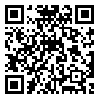Volume 13, Issue 3 (12-2021)
2021, 13(3): 123-130 |
Back to browse issues page
Ethics code: IR.MUMS.medical.REC.1398.260
Download citation:
BibTeX | RIS | EndNote | Medlars | ProCite | Reference Manager | RefWorks
Send citation to:



BibTeX | RIS | EndNote | Medlars | ProCite | Reference Manager | RefWorks
Send citation to:
Vafaei Ghayeni A, Golmakani H, Ashrafzade F, Heydarian F. Comparison of Serum Zinc Levels in Children with Epilepsy and Febrile Convulsions. North Khorasan University of Medical Sciences 2021; 13 (3) :123-130
URL: http://journal.nkums.ac.ir/article-1-2443-en.html
URL: http://journal.nkums.ac.ir/article-1-2443-en.html
1- Assistant Professor of Pediatrics, Mashhad University of Medical Sciences, Mashhad, Iran , atefe.vafayi@yahoo.com
2- Pediatric Neurologists and Professor of Mashhad University of Medical Sciences, Mashhad, Iran
3- Pediatrician and Professor of Mashhad University of Medical Sciences, Mashhad, Iran
2- Pediatric Neurologists and Professor of Mashhad University of Medical Sciences, Mashhad, Iran
3- Pediatrician and Professor of Mashhad University of Medical Sciences, Mashhad, Iran
Abstract: (2391 Views)
Introduction: Epilepsy is one of the most common and chronic neurological diseases in children. The prevalence of this disease among children in Iran is estimated at 5%, which is higher than the average prevalence in other countries. Several studies have been done on the role of trace elements in serum and its role in the pathogenesis of epilepsy, but there is still little information on the role of zinc and its serum level in children with epilepsy compared to fever-induced seizures.
Methods: Patients with febrile convulsion and epileptic patientsyounger than 6 years old and admitted to pediatric neurology ward of Ghaem hospital from mordad to azar 1398 were divided into two groups of 22 each with parental consent. The third group was selected as the control group with 22 patients in the same age range from febrile patients without pediatric seizure. The amount of 2 ml of blood was collected within the first 6 hours of admission and measured in the biochemical laboratory of Ghaem Hospital by a dedicated serum zinc expert. At the end the results were compared and then analyzed.
Results: A total of 22 epileptic children, 22 children with febrile seizure and 22 children with no seizure as control group were enrolled. The mean age of the patients in the study was 3.00±1.84. The results showed that the serum zinc level in the group of children with epilepsy was 84.53±29.42mg.L, in the febrile seizure group was 82.14±27.61mg.L and in the control group was 83.02±28.25mg.L. Results of statistical analysis showed that there was no significant difference between the three groups (P = 0.96). Statistical analysis also showed no significant difference between each two groups.
Conclusions: The results of this study show that there is no difference between serum zinc level between patients with febrile convulsion and those with epilepsy. However, according to the results of other studies, further studies with larger sample sizes are needed to obtain stronger evidence in this topic.
Methods: Patients with febrile convulsion and epileptic patientsyounger than 6 years old and admitted to pediatric neurology ward of Ghaem hospital from mordad to azar 1398 were divided into two groups of 22 each with parental consent. The third group was selected as the control group with 22 patients in the same age range from febrile patients without pediatric seizure. The amount of 2 ml of blood was collected within the first 6 hours of admission and measured in the biochemical laboratory of Ghaem Hospital by a dedicated serum zinc expert. At the end the results were compared and then analyzed.
Results: A total of 22 epileptic children, 22 children with febrile seizure and 22 children with no seizure as control group were enrolled. The mean age of the patients in the study was 3.00±1.84. The results showed that the serum zinc level in the group of children with epilepsy was 84.53±29.42mg.L, in the febrile seizure group was 82.14±27.61mg.L and in the control group was 83.02±28.25mg.L. Results of statistical analysis showed that there was no significant difference between the three groups (P = 0.96). Statistical analysis also showed no significant difference between each two groups.
Conclusions: The results of this study show that there is no difference between serum zinc level between patients with febrile convulsion and those with epilepsy. However, according to the results of other studies, further studies with larger sample sizes are needed to obtain stronger evidence in this topic.
Type of Study: Orginal Research |
Subject:
Basic Sciences
Received: 2019/12/15 | Accepted: 2021/05/11 | Published: 2021/12/1
Received: 2019/12/15 | Accepted: 2021/05/11 | Published: 2021/12/1
Send email to the article author
| Rights and permissions | |
 |
This work is licensed under a Creative Commons Attribution-NonCommercial 4.0 International License. |







